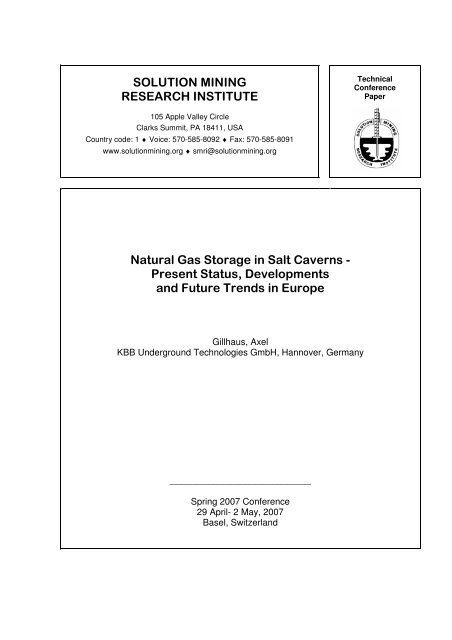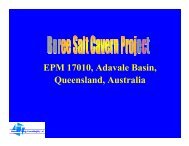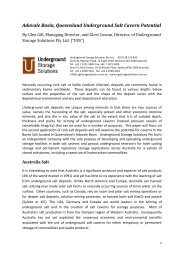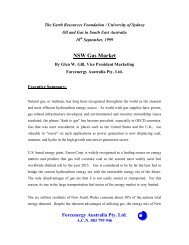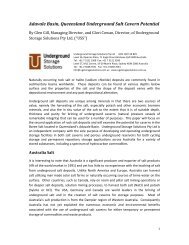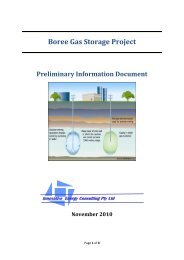Natural gas storage in salt caverns present trends in Europe
Natural gas storage in salt caverns present trends in Europe
Natural gas storage in salt caverns present trends in Europe
Create successful ePaper yourself
Turn your PDF publications into a flip-book with our unique Google optimized e-Paper software.
SOLUTION MINING<br />
RESEARCH INSTITUTE<br />
105 Apple Valley Circle<br />
Clarks Summit, PA 18411, USA<br />
Country code: 1 ♦ Voice: 570-585-8092 ♦ Fax: 570-585-8091<br />
www.solutionm<strong>in</strong><strong>in</strong>g.org ♦ smri@solutionm<strong>in</strong><strong>in</strong>g.org<br />
<strong>Natural</strong> Gas Storage <strong>in</strong> Salt Caverns -<br />
Present Status, Developments<br />
and Future Trends <strong>in</strong> <strong>Europe</strong><br />
Gillhaus, Axel<br />
KBB Underground Technologies GmbH, Hannover, Germany<br />
_______________________________<br />
Spr<strong>in</strong>g 2007 Conference<br />
29 April- 2 May, 2007<br />
Basel, Switzerland<br />
Technical<br />
Conference<br />
Paper
GILLHAUS, A. (2007): <strong>Natural</strong> <strong>gas</strong> <strong>storage</strong> <strong>in</strong> <strong>salt</strong> <strong>caverns</strong> – Present status, developments and future <strong>trends</strong> <strong>in</strong> <strong>Europe</strong><br />
Contents<br />
1 Abstract ....................................................................................................2<br />
2 Introduction..............................................................................................2<br />
3 Summary of <strong>gas</strong> cavern projects <strong>in</strong> <strong>Europe</strong> .........................................4<br />
3.1 Status quo and planned projects ............................................................................ 4<br />
3.2 Geological and geotechnical potential for <strong>gas</strong> cavern projects ............................... 7<br />
4 What’s new?...........................................................................................10<br />
4.1 Past and future <strong>storage</strong> objectives and the associated demands ......................... 10<br />
4.2 Use of less favourable <strong>salt</strong> formations.................................................................. 10<br />
5 Consequences .......................................................................................13<br />
5.1 Rock-mechanical design ...................................................................................... 13<br />
5.2 Thermodynamic design (<strong>gas</strong> hydrates, deliverability, turnover frequency)........... 14<br />
5.3 Drill<strong>in</strong>g and completion ......................................................................................... 15<br />
5.4 Modus operandi ................................................................................................... 15<br />
6 Cavern <strong>storage</strong>s for LNG receiv<strong>in</strong>g term<strong>in</strong>als ....................................17<br />
7 References .............................................................................................18<br />
page 1 of 18
GILLHAUS, A. (2007): <strong>Natural</strong> <strong>gas</strong> <strong>storage</strong> <strong>in</strong> <strong>salt</strong> <strong>caverns</strong> – Present status, developments and future <strong>trends</strong> <strong>in</strong> <strong>Europe</strong><br />
1 Abstract<br />
The <strong>in</strong>creas<strong>in</strong>g depletion of natural <strong>gas</strong> fields <strong>in</strong> central <strong>Europe</strong> and the accompany<strong>in</strong>g<br />
need to transported <strong>gas</strong> over extremely long distances, as well as the liberalisation of the<br />
<strong>gas</strong> trad<strong>in</strong>g bus<strong>in</strong>ess, is currently feed<strong>in</strong>g the market for additional <strong>gas</strong> <strong>storage</strong>s – mostly<br />
<strong>in</strong> <strong>salt</strong> <strong>caverns</strong>.<br />
This paper looks first at the status quo: the geographic spread of the stock of <strong>gas</strong> cavern<br />
<strong>storage</strong>s <strong>in</strong> <strong>Europe</strong>, the current technical standards and the geological requirements for<br />
the <strong>in</strong>stallation of additional <strong>storage</strong>s. This will be followed by a discussion of the latest<br />
<strong>trends</strong> and developments, and the associated geotechnical and technological challenges.<br />
Unlike <strong>in</strong> the past when cavern <strong>storage</strong>s were primarily constructed <strong>in</strong> thick,<br />
homogeneous <strong>salt</strong> deposits at favourable depths between around 900 -1 700 m, the<br />
<strong>Europe</strong>an expansion <strong>in</strong> demand for <strong>storage</strong> capacities means that less favourable <strong>salt</strong><br />
deposits also have to be utilised. This primarily <strong>in</strong>volves th<strong>in</strong>ner and <strong>in</strong>homogeneous <strong>salt</strong><br />
sequences at depths which are either very shallow or very deep.<br />
New challenges also result from the <strong>in</strong>creas<strong>in</strong>g demand for merchant <strong>storage</strong>s, which are<br />
characterised by frequent turnover and high deliverability. The associated modus operandi<br />
of such <strong>caverns</strong> <strong>in</strong>creases the mechanical and thermal stress on the host <strong>salt</strong> rock. This<br />
has demanded the development of advanced dimension<strong>in</strong>g concepts.<br />
2 Introduction<br />
25 % of <strong>Europe</strong>’s primary energy consumption is covered by natural <strong>gas</strong>. <strong>Natural</strong> <strong>gas</strong><br />
consumption <strong>in</strong> <strong>Europe</strong> (EU 25, Norway, Switzerland, Romania, Bulgaria and Turkey)<br />
reached over 530 billion m 3 <strong>in</strong> 2005 of which around 300 billion m 3 or 55 % was produced<br />
<strong>in</strong> <strong>Europe</strong> (ma<strong>in</strong>ly UK, Norway and the Netherlands). Around 230 billion m 3 of natural <strong>gas</strong>,<br />
or 45 % of the total consumption, was produced <strong>in</strong> non-<strong>Europe</strong>an countries (primarily<br />
Asian regions of Russia, Algeria; www.terra<strong>gas</strong>.at). <strong>Europe</strong> ma<strong>in</strong>ly imports its natural <strong>gas</strong><br />
through pipel<strong>in</strong>es, only 12 % of the imports are supplied as LNG from sources <strong>in</strong> North<br />
Africa, Nigeria and the Middle East.<br />
As global energy demand rises, natural <strong>gas</strong> is <strong>in</strong>creas<strong>in</strong>gly replac<strong>in</strong>g crude oil as one of<br />
the ma<strong>in</strong> energy sources because natural <strong>gas</strong> is the most environment-friendly fossil fuel<br />
with the lowest CO2 emissions and there are much higher reserves of natural <strong>gas</strong> than<br />
crude oil (GERLING et al. 2005). The strong <strong>in</strong>crease <strong>in</strong> natural <strong>gas</strong> consumption <strong>in</strong> <strong>Europe</strong><br />
overall, aga<strong>in</strong>st the background of dim<strong>in</strong>ish<strong>in</strong>g domestic <strong>gas</strong> production, <strong>in</strong>creases<br />
<strong>Europe</strong>’s dependency on natural <strong>gas</strong> imports from remote third countries. This <strong>in</strong> turn<br />
page 2 of 18
GILLHAUS, A. (2007): <strong>Natural</strong> <strong>gas</strong> <strong>storage</strong> <strong>in</strong> <strong>salt</strong> <strong>caverns</strong> – Present status, developments and future <strong>trends</strong> <strong>in</strong> <strong>Europe</strong><br />
<strong>in</strong>creases the importance of natural <strong>gas</strong> <strong>storage</strong> to ensure supply security (e.g.<br />
BARBKNECHT 2006).<br />
The natural <strong>gas</strong> <strong>storage</strong> volume <strong>in</strong> 20 countries <strong>in</strong> <strong>Europe</strong> <strong>in</strong> 2006 was almost 80 billion m 3<br />
(Vst work<strong>in</strong>g <strong>gas</strong>). This was stored <strong>in</strong> porous and cavern <strong>storage</strong>s, and accounts for<br />
approx. 15 % of the annual demand. The largest shares of the total stored volume <strong>in</strong><br />
<strong>Europe</strong> are found <strong>in</strong> Germany (19 billion m 3 Vst), Italy (17 billion m 3 Vst) and France (11<br />
billion m 3 Vst) (IGU 2006, SEDLACEK 2006). This disguises, however, the huge variation <strong>in</strong><br />
the proportion of <strong>storage</strong> capacity to total consumption <strong>in</strong> each <strong>Europe</strong>an country (Fig. 1):<br />
Latvia’s <strong>storage</strong>s for <strong>in</strong>stance account for more than 100 % of annual natural <strong>gas</strong><br />
consumption, whilst the <strong>storage</strong> volume to annual demand ratio of only 4 % <strong>in</strong> the UK is<br />
the lowest proportion <strong>in</strong> <strong>Europe</strong>.<br />
Figure 1: Specific <strong>storage</strong> capacity of some <strong>Europe</strong>an countries (modified from<br />
web.w<strong>in</strong>tershall.com).<br />
Gas <strong>storage</strong>s are primarily built to balance out the strong fluctuation <strong>in</strong> seasonal demand,<br />
and for peak shav<strong>in</strong>g. Storages are important for establish<strong>in</strong>g cont<strong>in</strong>uous supply and<br />
production from remote <strong>gas</strong> fields and to optimise the efficiency of the pipel<strong>in</strong>es. Gas<br />
<strong>storage</strong>s are also vital for strategic <strong>gas</strong> purchas<strong>in</strong>g, secur<strong>in</strong>g <strong>gas</strong> supplies, and bridg<strong>in</strong>g<br />
technical or political shortfalls <strong>in</strong> deliveries.<br />
The dynamic growth <strong>in</strong> <strong>storage</strong> capacities currently tak<strong>in</strong>g place <strong>in</strong> <strong>Europe</strong> reflects a<br />
number of different factors:<br />
• The decl<strong>in</strong>e <strong>in</strong> <strong>gas</strong> production <strong>in</strong> the UK means that the country is chang<strong>in</strong>g from a<br />
<strong>gas</strong> exporter to a net <strong>gas</strong> importer, a situation which requires <strong>storage</strong>s (currently<br />
only account<strong>in</strong>g for approx. 4 % of annual consumption)<br />
• Liberalisation of <strong>gas</strong> trad<strong>in</strong>g has <strong>in</strong>itiated a demand for trad<strong>in</strong>g <strong>storage</strong>s<br />
page 3 of 18
GILLHAUS, A. (2007): <strong>Natural</strong> <strong>gas</strong> <strong>storage</strong> <strong>in</strong> <strong>salt</strong> <strong>caverns</strong> – Present status, developments and future <strong>trends</strong> <strong>in</strong> <strong>Europe</strong><br />
• The <strong>in</strong>creas<strong>in</strong>g importance of <strong>gas</strong> supplies from remote regions requires<br />
additional <strong>storage</strong>s for seasonal balanc<strong>in</strong>g and to compensate for any supply<br />
shortfalls.<br />
• Storages are needed for the <strong>gas</strong> grids be<strong>in</strong>g built <strong>in</strong> countries such as Spa<strong>in</strong> and<br />
Portugal with <strong>in</strong>creas<strong>in</strong>g number of <strong>gas</strong>-fired power plants<br />
Cavern <strong>storage</strong>s are ga<strong>in</strong><strong>in</strong>g <strong>in</strong> significance <strong>in</strong> this context because they can be more<br />
flexibly operated than porous <strong>storage</strong>s, and the specific costs and risks are much lower<br />
compared to aquifer <strong>storage</strong>s.<br />
The subsequent discussion focuses on the geological and geotechnical aspects of the<br />
construction of future natural <strong>gas</strong> cavern <strong>storage</strong>s.<br />
3 Summary of <strong>gas</strong> cavern projects <strong>in</strong> <strong>Europe</strong><br />
Cavern <strong>storage</strong>s account for approx. 11.5 % of <strong>Europe</strong>an <strong>storage</strong> capacity, i.e. around 9<br />
billion m 3 (Vst). This low proportion is attributable to the much higher overall capacities and<br />
the lower <strong>in</strong>vestment costs for construct<strong>in</strong>g pore <strong>storage</strong>s <strong>in</strong> depleted oil and <strong>gas</strong> fields<br />
(SPRECKELS & CROTOGINO 2002). The follow<strong>in</strong>g first discusses the status of <strong>Europe</strong>an <strong>gas</strong><br />
cavern <strong>storage</strong> projects <strong>in</strong> more detail and then looks at the geological and geotechnical<br />
potential for additional projects <strong>in</strong> <strong>Europe</strong>.<br />
3.1 Status quo and planned projects<br />
Gas <strong>storage</strong> <strong>caverns</strong> currently exist <strong>in</strong> six <strong>Europe</strong>an countries. They are located at 28<br />
different sites (or 34 cavern facilities) of which 17 alone (or 23) are <strong>in</strong> Germany, four <strong>in</strong> the<br />
UK and three <strong>in</strong> France. Denmark, Poland and Portugal each have one <strong>salt</strong> cavern <strong>gas</strong><br />
<strong>storage</strong> (Fig. 2). The work<strong>in</strong>g <strong>gas</strong> volume <strong>in</strong> the 229 <strong>Europe</strong>an <strong>gas</strong> <strong>storage</strong> <strong>caverns</strong> is<br />
around 9 billion m 3 (Vst) of which 6.8 billion m 3 (Vst) or 75 % lies <strong>in</strong> Germany (158 <strong>caverns</strong>)<br />
(Tab. 1). This concentration of cavern <strong>storage</strong>s <strong>in</strong> North Germany highlights the<br />
favourable geological conditions for the construction of cavern <strong>storage</strong>s <strong>in</strong> North Germany<br />
and Germany’s favourable position overall relative to the exist<strong>in</strong>g North <strong>Europe</strong>an natural<br />
<strong>gas</strong> suppliers <strong>in</strong> Norway, the Netherlands, the UK and Russia.<br />
The expansion of 14 <strong>gas</strong> cavern <strong>storage</strong>s (64 <strong>caverns</strong>) is planned for the near future. This<br />
<strong>in</strong>volves an <strong>in</strong>crease <strong>in</strong> the available work<strong>in</strong>g <strong>gas</strong> volume of approx. 3.5 billion m 3 or<br />
around 39 % of the current volume. 12 <strong>storage</strong>s with an additional 3.2 billion m 3 (approx.<br />
90 %) are to be expanded <strong>in</strong> Germany alone, whilst the other three are <strong>in</strong> France, Poland<br />
and the UK (Fig. 3, Tab. 1). The large number of expansion projects <strong>in</strong> Germany<br />
highlights the country’s favourable position with respect to Russia as the ma<strong>in</strong> <strong>gas</strong><br />
supplier and enhances Germany’s position as a transit country.<br />
page 4 of 18
GILLHAUS, A. (2007): <strong>Natural</strong> <strong>gas</strong> <strong>storage</strong> <strong>in</strong> <strong>salt</strong> <strong>caverns</strong> – Present status, developments and future <strong>trends</strong> <strong>in</strong> <strong>Europe</strong><br />
Figure 2: Exist<strong>in</strong>g cavern fields, <strong>gas</strong> pipel<strong>in</strong>es and LNG import term<strong>in</strong>als <strong>in</strong> <strong>Europe</strong><br />
(Compiled from PETROLEUM ECONOMIST, 2002; GAS INFRASTRUCTURE EUROPE,<br />
2006; GILLHAUS et al., 2006; HORVATH & GILLHAUS, submitted).<br />
In addition to the expansion projects, 15 new <strong>gas</strong> cavern <strong>storage</strong>s are planned and under<br />
construction with a work<strong>in</strong>g <strong>gas</strong> volume of approx. 7.1 billion m 3 . Six of these projects with<br />
a planned work<strong>in</strong>g <strong>gas</strong> volume of approx. 4.5 billion m 3 (approx. 64 %) are planned <strong>in</strong> the<br />
UK alone (Fig. 3, Tab. 1). The large proportion of planned new <strong>caverns</strong> <strong>in</strong> the UK<br />
highlights the urgent need <strong>in</strong> that country for the construction of extra <strong>storage</strong> capacities.<br />
The UK only became a net natural <strong>gas</strong> importer <strong>in</strong> recent years and is the third largest<br />
consumer of natural <strong>gas</strong> world-wide. Three new <strong>storage</strong>s are planned <strong>in</strong> Germany. The<br />
Netherlands and France both have one <strong>storage</strong> under construction. Bulgaria plans to<br />
construct its first <strong>gas</strong> cavern <strong>storage</strong>.<br />
page 5 of 18
Gillhaus, A. (2007): <strong>Natural</strong> <strong>gas</strong> <strong>storage</strong> <strong>in</strong> <strong>salt</strong> <strong>caverns</strong> - Present status, developments and future <strong>trends</strong> <strong>in</strong> <strong>Europe</strong><br />
Country Cavern field Operator<br />
Current<br />
cavern<br />
number<br />
Current<br />
work<strong>in</strong>g<br />
<strong>gas</strong> volume<br />
[10^6 m³]<br />
Number<br />
of<br />
<strong>caverns</strong><br />
Additional<br />
work<strong>in</strong>g<br />
<strong>gas</strong> volume<br />
[10^6 m³]<br />
Caverns<br />
under<br />
construction<br />
Caverns<br />
planned<br />
Additional<br />
work<strong>in</strong>g<br />
<strong>gas</strong> volume<br />
[10^6 m³]<br />
Bulgaria Mirovo Topenergy (Bulgar<strong>gas</strong> + Gazprom) 0 0 0 0 0 unknown 400<br />
Denmark Ll. Torup DONG 7 420 0 0 0 0 0<br />
France<br />
Germany<br />
Etrez Gaz de France 15 452 6 180* 0 0 0<br />
Manosque Gaz de France 7 212 0 0 0 0 0<br />
Tersanne Gaz de France 14 204 0 0 0 0 0<br />
Hauterives Gaz de France 0 0 0 0 5 0 100*<br />
Bad Lauchstädt Verbundnetz Gas AG 18 546 0 0 0 0 0<br />
Bernburg Verbundnetz Gas AG 31 895 6 270 0 0 0<br />
Bremen-Lesum swb Netze GmbH & Co. KG 2 75 0 0 0 0 0<br />
Bremen-Lesum EMPG for BEB Erd<strong>gas</strong> and Erdöl GmbH 2 177 0 0 0 0 0<br />
Empelde GHG-Gasspeicher Hannover GmbH 3 140 1 113 0 0 0<br />
Epe E.ON Ruhr<strong>gas</strong> AG 32 1657 0 0 0 0 0<br />
Epe<br />
RWE WWE Netzservice GmbH,<br />
Thyssen<strong>gas</strong> GmbH<br />
8 352 2 145 0 0 0<br />
Epe Essent Energie Gasspeicher GmbH 3 165 1 56 0 0 0<br />
Epe NUON UGS Epe GmbH 2 70 2 185 0 0 0<br />
Epe Trianel Gasspeichergesellschaft Epe 0 0 0 0 3 0 120<br />
Etzel IVG Logistik GmbH 9 560 20 1200* 0 0 0<br />
Harsefeld EMPG for BEB Erd<strong>gas</strong> und Erdöl GmbH 2 132 0 0 0 0 0<br />
Huntorf EWE AG 6 298 0 0 0 0 0<br />
Jemgum W<strong>in</strong>tershall AG 0 0 0 0 0 10 700<br />
Kiel-Rönne Stadtwerke Kiel AG, E.ON Hanse AG 2 60 1 54 0 0 0<br />
Kraak E.ON Hanse AG 2 117 0 0 0 0 0<br />
Krummhörn E.ON Ruhr<strong>gas</strong> AG 3 51 0 0 0 0 0<br />
Möckow EWE AG 0 0 0 0 0 unknown unknown<br />
Neuenhuntorf EWE AG 1 17 0 0 0 0 0<br />
Nüttermoor EWE AG 16 922 2 175 0 0 0<br />
Peckensen EEG-Erd<strong>gas</strong> Erdöl GmbH 1 60 10 600 0 0 0<br />
Reckrod Gas-Union GmbH 3 112 0 0 0 0 0<br />
Reckrod-Wölf W<strong>in</strong>tershall AG 0 0 0 0 0 2 120<br />
Rüdersdorf EWE AG 0 0 0 0 2 0 165<br />
Staßfurt<br />
Xanten<br />
Kavernenspeicher Staßfurt GmbH,<br />
RWE WWE Netzservice GmbH<br />
RWE WWE Netzservice GmbH,<br />
Thyssen<strong>gas</strong> GmbH<br />
4 204 4 290 0 0 0<br />
8 190 5 125 0 0 0<br />
Netherlands Zuidwend<strong>in</strong>g Gasunie / NUON 0 0 0 0 4 0 190<br />
Poland Mogilno Polish Oil and Gas Company (PGNiG) 8 416 2 104 0 0 0<br />
Portugal Carriço Trans<strong>gas</strong> 4 200 0 0 0 0 0<br />
Russia Kal<strong>in</strong><strong>in</strong>grad Gazprom 0 0 0 0 0 14 800<br />
United<br />
K<strong>in</strong>gdom<br />
* estimated<br />
Current cavern<br />
<strong>storage</strong>s<br />
Extension of exist<strong>in</strong>g<br />
cavern <strong>storage</strong>s<br />
New cavern <strong>storage</strong>s<br />
Holford Ineos Enterprises 1 0.175 0 0 0 0 0<br />
Holehouse Energy Merchants Gas Storage Ltd. 2 28 2 28 0 0 0<br />
Byley E.ON UK 0 0 0 0 8 0 160<br />
Fleetwood Canatxx Gas Storage Ltd. 0 0 0 0 0 20 1700<br />
Stublach Ineos Enterprises 0 0 0 0 0 28 400<br />
Isle of Portland Portland Gas Ltd. 0 0 0 0 0 14 1000<br />
Teesside SABIC UK Petrochemicals 4 2.8* 0 0 0 0 0<br />
Aldbrough SSE Hornsea Ltd. and Statoil 0 0 0 0 9 9 840<br />
Aldbrough Whitehill E.ON UK 0 0 0 0 0 10 420<br />
Hornsea-Atwick SSE Hornsea Ltd. 9 325 0 0 0 0 0<br />
TOTAL<br />
229 9060 64 3525 31 107 7115<br />
Table 1: Present status, extensions and new projects of natural <strong>gas</strong> cavern <strong>storage</strong>s <strong>in</strong> <strong>Europe</strong> -<br />
Data compiled from Sedlacek (2006), IGU (2006) and current press releases.<br />
page 6 of 18
GILLHAUS, A. (2007): <strong>Natural</strong> <strong>gas</strong> <strong>storage</strong> <strong>in</strong> <strong>salt</strong> <strong>caverns</strong> – Present status, developments and future <strong>trends</strong> <strong>in</strong> <strong>Europe</strong><br />
Figure 3: Expansion and new construction projects for <strong>gas</strong> cavern <strong>storage</strong>s, pipel<strong>in</strong>es<br />
and LNG import term<strong>in</strong>als <strong>in</strong> <strong>Europe</strong> (Compiled from PETROLEUM ECONOMIST,<br />
2002; GAS INFRASTRUCTURE EUROPE, 2006; Current press releases).<br />
3.2 Geological and geotechnical potential for <strong>gas</strong> cavern projects<br />
Favourable conditions for the formation of rock <strong>salt</strong> deposits existed <strong>in</strong> <strong>Europe</strong> dur<strong>in</strong>g the<br />
Permian, several periods dur<strong>in</strong>g the Mesozoic, and <strong>in</strong> the Tertiary. Figure 4 shows a map<br />
with the distribution of underground <strong>salt</strong> deposits and all of the exist<strong>in</strong>g cavern fields <strong>in</strong><br />
<strong>Europe</strong> (GILLHAUS et al., 2006; HORVATH & GILLHAUS, submitted).<br />
The notable concentration of <strong>gas</strong> cavern <strong>storage</strong>s <strong>in</strong> North Germany is primarily<br />
attributable to the geology as well as Germany’s central position <strong>in</strong> <strong>Europe</strong> for <strong>gas</strong><br />
page 7 of 18
GILLHAUS, A. (2007): <strong>Natural</strong> <strong>gas</strong> <strong>storage</strong> <strong>in</strong> <strong>salt</strong> <strong>caverns</strong> – Present status, developments and future <strong>trends</strong> <strong>in</strong> <strong>Europe</strong><br />
transport/import and <strong>gas</strong> <strong>storage</strong>. All of Germany’s 23 <strong>gas</strong> cavern localities are associated<br />
with the thick Palaeozoic <strong>salt</strong> laid down <strong>in</strong> the Permian.<br />
Figure 4: Underground <strong>salt</strong> deposits and cavern fields <strong>in</strong> <strong>Europe</strong> (modified from<br />
GILLHAUS et al., 2006; HORVATH & GILLHAUS, submitted).<br />
Structures with Rotliegendes <strong>salt</strong> (Lower Permian) only exist <strong>in</strong> the extreme north of<br />
Germany. These deposits consist of <strong>in</strong>homogeneous breccias with NaCl concentrations<br />
averag<strong>in</strong>g only approx. 60 – 80 vol.-%. The high proportion of <strong>in</strong>solubles (claystone)<br />
considerably dim<strong>in</strong>ishes the net volume of the <strong>caverns</strong> at the only Rotliegendes <strong>storage</strong><br />
locality located near Kiel.<br />
page 8 of 18
GILLHAUS, A. (2007): <strong>Natural</strong> <strong>gas</strong> <strong>storage</strong> <strong>in</strong> <strong>salt</strong> <strong>caverns</strong> – Present status, developments and future <strong>trends</strong> <strong>in</strong> <strong>Europe</strong><br />
The high quality Zechste<strong>in</strong> <strong>salt</strong> deposits (Upper Permian) <strong>in</strong> the Central <strong>Europe</strong>an bas<strong>in</strong><br />
systems usually have very favourable properties for <strong>gas</strong> cavern construction because of<br />
their large thickness and their high proportion of halite (> 90 vol.-%). The follow<strong>in</strong>g are<br />
found at suitable depths <strong>in</strong> the German Zechste<strong>in</strong> <strong>salt</strong> sequence<br />
• The widespread occurrence of bedded <strong>salt</strong> with thicknesses exceed<strong>in</strong>g several<br />
100 m<br />
• More than 200 <strong>salt</strong> domes with <strong>salt</strong> thicknesses of more than 1000 m <strong>in</strong> part<br />
In the <strong>salt</strong> domes <strong>in</strong> particular, it is important to f<strong>in</strong>d solution-m<strong>in</strong>able <strong>salt</strong> with the lowest<br />
possible number of <strong>in</strong>terbeds of easily soluble potash <strong>salt</strong>s with<strong>in</strong> the ideal depth <strong>in</strong>terval<br />
of 900 to 1700 m. Poorly soluble <strong>in</strong>terbeds (anhydrite, claystone) occur very rarely <strong>in</strong> the<br />
<strong>salt</strong> domes which are therefore highly suitable for the construction of cavern <strong>storage</strong>s.<br />
Other <strong>salt</strong> domes conta<strong>in</strong><strong>in</strong>g high quality Zechste<strong>in</strong> <strong>salt</strong> sequences at suitable depths are<br />
found <strong>in</strong> the north-eastern Netherlands (14 <strong>salt</strong> domes), north-western Denmark (16 <strong>salt</strong><br />
domes) and Central Poland (10 <strong>salt</strong> domes). The Zechste<strong>in</strong> bedded <strong>salt</strong>s <strong>in</strong> these<br />
countries tend to lie at excessive depths too deep for the construction of <strong>gas</strong> cavern<br />
<strong>storage</strong>s. The geological/geotechnical potential for <strong>gas</strong> cavern projects <strong>in</strong> these countries<br />
therefore considerably exceeds demand.<br />
The UK’s position at the edge of the Zechste<strong>in</strong> Bas<strong>in</strong> means that the sequences of pure<br />
Zechste<strong>in</strong> <strong>salt</strong>s are much th<strong>in</strong>ner than on the Cont<strong>in</strong>ent. The depths at the localities used<br />
so far for the construction of <strong>storage</strong>s also tend to be deeper than 1700 m (Zechste<strong>in</strong> 2) or<br />
shallower than 500 m (Zechste<strong>in</strong> 3). The ratio of technical/f<strong>in</strong>ancial costs to the capacity of<br />
the <strong>storage</strong>s is therefore much more unfavourable than most of the other <strong>gas</strong> cavern fields<br />
constructed <strong>in</strong> Zechste<strong>in</strong> <strong>salt</strong>.<br />
Other <strong>gas</strong> cavern <strong>storage</strong>s are successfully operated <strong>in</strong> Mesozoic <strong>salt</strong> (UK, Portugal) and<br />
Tertiary <strong>salt</strong> (France)<br />
Bedded <strong>salt</strong> of Keuper age (Lower Triassic) is used for <strong>gas</strong> <strong>storage</strong> at two localities <strong>in</strong> the<br />
western UK. They lie at depths of less than 700 m and have a high proportion of<br />
<strong>in</strong>solubles (claystone). These non-<strong>salt</strong> layers can be up to 10 m thick and therefore h<strong>in</strong>der<br />
the solution m<strong>in</strong><strong>in</strong>g process and restrict the volume of the <strong>caverns</strong>. It is also much more<br />
complicated to confirm the <strong>in</strong>tegrity of <strong>caverns</strong> built <strong>in</strong> such unfavourable <strong>salt</strong> formations.<br />
Nevertheless, the technical and economic feasibility has already been proven for several<br />
sites and the construction and plann<strong>in</strong>g of other <strong>gas</strong> <strong>storage</strong> projects <strong>in</strong> these formations<br />
are thus under way.<br />
Keuper <strong>salt</strong>s of similar quality are used <strong>in</strong> the rest of <strong>Europe</strong> for br<strong>in</strong>e production at<br />
various localities (Fig. 4). The Keuper <strong>salt</strong>s are found as bedded <strong>salt</strong>, <strong>salt</strong> breccias or <strong>salt</strong><br />
page 9 of 18
GILLHAUS, A. (2007): <strong>Natural</strong> <strong>gas</strong> <strong>storage</strong> <strong>in</strong> <strong>salt</strong> <strong>caverns</strong> – Present status, developments and future <strong>trends</strong> <strong>in</strong> <strong>Europe</strong><br />
domes and have generally been considered <strong>in</strong> the past to be unsuitable for the<br />
construction of <strong>gas</strong> <strong>storage</strong>s. However, the grow<strong>in</strong>g demand for <strong>storage</strong> capacities at<br />
some localities <strong>in</strong> Spa<strong>in</strong>, France and Switzerland could stimulate the exploration of these<br />
<strong>salt</strong> sequences.<br />
In Portugal, there are <strong>salt</strong> domes with <strong>salt</strong> laid down at the Triassic-Jurassic boundary<br />
and which lie at suitable depths for the construction of <strong>gas</strong> cavern <strong>storage</strong>s. The first and<br />
so far only <strong>gas</strong> cavern <strong>storage</strong> on the Iberian pen<strong>in</strong>sula was constructed at Carriço <strong>in</strong><br />
Portugal. Although the <strong>salt</strong> <strong>in</strong> the <strong>salt</strong> dome used for the cavern <strong>storage</strong> consists of an<br />
<strong>in</strong>homogeneous breccia conta<strong>in</strong><strong>in</strong>g large non-<strong>salt</strong> blocks, there is probably additional<br />
potential for the construction of other <strong>storage</strong>s along the west coast of Portugal.<br />
Thick tectonised bedded <strong>salt</strong> of Tertiary age is used for the construction of <strong>gas</strong> <strong>storage</strong>s<br />
<strong>in</strong> France. They conta<strong>in</strong> high concentrations of <strong>in</strong>solubles compared to the North German<br />
<strong>salt</strong> structures, but have adequate potential for the future thanks to the homogenous<br />
nature of the <strong>salt</strong> and the suitable depths.<br />
The Tertiary <strong>salt</strong> formations <strong>in</strong> <strong>Europe</strong> are very localised. Nevertheless, all of the deposits<br />
are used, at least for <strong>salt</strong> production. Most of the deposits are very strongly tectonised<br />
bedded <strong>salt</strong> sequences (<strong>salt</strong> breccias). There are also large <strong>salt</strong> domes of Tertiary age <strong>in</strong><br />
Rumania. In Rumania and possibly also <strong>in</strong> southern Italy, the Tertiary <strong>salt</strong> is known to be<br />
thick enough and at suitable depths for the construction of <strong>gas</strong> cavern <strong>storage</strong>s.<br />
4 What’s new?<br />
4.1 Past and future <strong>storage</strong> objectives and the associated demands<br />
Although cavern <strong>storage</strong>s tend to be more suitable for the shav<strong>in</strong>g of consumption peaks,<br />
they are often also used for seasonal balanc<strong>in</strong>g. Figure 5 shows the wellhead pressure of<br />
such a cavern over a period of several years. The liberalisation of the <strong>gas</strong> market has<br />
opened up a new application for short-term <strong>gas</strong> trad<strong>in</strong>g (arbitrage). The technical<br />
consequences of this are more frequent turnovers, higher deliverability, and especially<br />
<strong>in</strong>jectability and higher rates which significantly raise the stress <strong>in</strong> the <strong>salt</strong> surround<strong>in</strong>g the<br />
cavern.<br />
4.2 Use of less favourable <strong>salt</strong> formations<br />
The <strong>in</strong>creas<strong>in</strong>g demand for <strong>gas</strong> <strong>storage</strong> capacities and the construction of flexible<br />
merchant <strong>storage</strong>s <strong>in</strong> particular has generated a cavern construction boom. This means<br />
that <strong>salt</strong> formations previously considered less suitable also have to be taken <strong>in</strong>to<br />
consideration <strong>in</strong> addition to the prime sites ma<strong>in</strong>ly used <strong>in</strong> the past.<br />
page 10 of 18
Wellhead pressure (bar)<br />
GILLHAUS, A. (2007): <strong>Natural</strong> <strong>gas</strong> <strong>storage</strong> <strong>in</strong> <strong>salt</strong> <strong>caverns</strong> – Present status, developments and future <strong>trends</strong> <strong>in</strong> <strong>Europe</strong><br />
150<br />
125<br />
100<br />
75<br />
50<br />
Seasonal peak shav<strong>in</strong>g by <strong>gas</strong> <strong>caverns</strong><br />
Januar 97 year #1 Januar 98 year #2Januar 99 year #3Januar 00 year Dezember #4 00<br />
Time<br />
Figure 5: Well head pressure of a <strong>gas</strong> cavern for saisonal <strong>storage</strong> <strong>in</strong>clud<strong>in</strong>g peak<br />
shav<strong>in</strong>g.<br />
Most of the exist<strong>in</strong>g <strong>gas</strong> cavern <strong>storage</strong>s <strong>in</strong> <strong>Europe</strong> were constructed <strong>in</strong> the past <strong>in</strong><br />
relatively simple, largely homogenous <strong>salt</strong> structures <strong>in</strong>clud<strong>in</strong>g thick bedded <strong>salt</strong><br />
sequences and <strong>salt</strong> pillows (e.g. Epe, Bernburg, Etrez), as well as <strong>salt</strong> domes (e.g.<br />
Nüttermoor, Ll. Torup) which developed from thick primary bedded <strong>salt</strong> sequences and<br />
<strong>salt</strong> pillows as a result of halotectonics. The stability and <strong>in</strong>tegrity of a cavern constructed<br />
<strong>in</strong> homogenous <strong>salt</strong> structures of this k<strong>in</strong>d is primarily determ<strong>in</strong>ed by the properties of the<br />
surround<strong>in</strong>g <strong>salt</strong> (Fig. 6).<br />
Figure 6: Influence of <strong>salt</strong> and non-<strong>salt</strong> on the <strong>in</strong>tegrity of <strong>caverns</strong> <strong>in</strong> homogenous and<br />
<strong>in</strong>homogeneous <strong>salt</strong> formations.<br />
The expansion or construction of new <strong>storage</strong>s is usually realised <strong>in</strong> favourable <strong>salt</strong><br />
formations of this type wherever possible. North Germany benefits from the frequent w<strong>in</strong>-<br />
w<strong>in</strong> situation where favourable locations from a <strong>gas</strong> bus<strong>in</strong>ess po<strong>in</strong>t of view are often<br />
page 11 of 18
GILLHAUS, A. (2007): <strong>Natural</strong> <strong>gas</strong> <strong>storage</strong> <strong>in</strong> <strong>salt</strong> <strong>caverns</strong> – Present status, developments and future <strong>trends</strong> <strong>in</strong> <strong>Europe</strong><br />
associated with geologically favourable <strong>salt</strong> formations: EWE AG for <strong>in</strong>stance plans to<br />
construct a new <strong>gas</strong> cavern <strong>storage</strong> <strong>in</strong> the only suitable <strong>salt</strong> structure (Möckow) right next<br />
to the landfall of the Nord Stream Pipel<strong>in</strong>e (planned for commission<strong>in</strong>g <strong>in</strong> 2010, cf. Fig. 3).<br />
Most countries <strong>in</strong> western, southern and south-eastern <strong>Europe</strong> have less favourable<br />
geological conditions available for the construction of <strong>gas</strong> <strong>storage</strong> <strong>caverns</strong> even though<br />
almost every <strong>salt</strong> deposit <strong>in</strong> <strong>Europe</strong> conta<strong>in</strong>s <strong>caverns</strong> for br<strong>in</strong>e production or the <strong>storage</strong> of<br />
other media (Fig. 4). However, the <strong>salt</strong> formations here are usually th<strong>in</strong>ner than <strong>in</strong><br />
northern central <strong>Europe</strong> and also often at unfavourable depths for <strong>gas</strong> <strong>storage</strong>. The <strong>salt</strong><br />
sections suitable for cavern development are also often <strong>in</strong>homogeneous. Th<strong>in</strong> <strong>salt</strong><br />
sequences at unfavourable depths are associated with small cavern volumes and/or small<br />
differences between maximum and m<strong>in</strong>imum permissible pressures – which all <strong>in</strong>crease<br />
the cost per cubic metre of stored work<strong>in</strong>g <strong>gas</strong>.<br />
In addition, the <strong>in</strong>tegrity of <strong>caverns</strong> constructed <strong>in</strong> <strong>in</strong>homogeneous <strong>salt</strong> structures no<br />
longer solely relies on the quality of the surround<strong>in</strong>g <strong>salt</strong>: they also have to rely on the<br />
favourable <strong>in</strong>teraction between different geological formations. Non-<strong>salt</strong> formations <strong>in</strong> such<br />
cases can be <strong>in</strong> direct contact with the medium <strong>in</strong> the cavern or <strong>in</strong> the immediate vic<strong>in</strong>ity<br />
(Fig. 6). This <strong>in</strong>volves e.g.:<br />
• Salt formations with a large proportion of <strong>in</strong>solubles (> approx. 15 %)<br />
• Competent <strong>in</strong>soluble beds (e.g. dolomite, anhydrite, clay) above and/or below the<br />
cavern<br />
• Competent <strong>in</strong>soluble beds which cut through the cavern zone<br />
• Faults <strong>in</strong> non-<strong>salt</strong> layers near the cavern<br />
The exploration and feasibility-test<strong>in</strong>g of unfavourable <strong>salt</strong> formations is often associated<br />
with much higher costs for <strong>in</strong> situ tests, laboratory analysis and computer modell<strong>in</strong>g.<br />
The UK is an example of a country where a number of such <strong>in</strong>homogeneous <strong>salt</strong><br />
structures requir<strong>in</strong>g high exploration and plann<strong>in</strong>g costs have to be used – it is also the<br />
country with the highest demand for additional capacity (see above). All of the localities<br />
are affected by th<strong>in</strong> <strong>salt</strong> formations at depths which are normally considered either quite<br />
shallow (Cheshire <strong>in</strong> the west) or quite deep (East Yorkshire, Devonshire). These<br />
problems are exacerbated by the <strong>in</strong>homogeneity of the <strong>salt</strong> formations, particularly <strong>in</strong> the<br />
west.<br />
page 12 of 18
GILLHAUS, A. (2007): <strong>Natural</strong> <strong>gas</strong> <strong>storage</strong> <strong>in</strong> <strong>salt</strong> <strong>caverns</strong> – Present status, developments and future <strong>trends</strong> <strong>in</strong> <strong>Europe</strong><br />
5 Consequences<br />
5.1 Rock-mechanical design<br />
Modern merchant <strong>storage</strong>s place higher and quite different demands on the rock-<br />
mechanical design of the <strong>salt</strong> <strong>caverns</strong> <strong>in</strong>volved. This is because of the more frequent<br />
turnovers, the higher withdrawal rates, and particularly, the higher <strong>in</strong>jection rates.<br />
Unlike <strong>storage</strong>s constructed <strong>in</strong> the past ma<strong>in</strong>ly for seasonable balanc<strong>in</strong>g plus some peak<br />
shav<strong>in</strong>g - which were therefore only affected by one turnover per year - future merchant<br />
<strong>storage</strong>s have to cope with up to ten turnovers per annum and the associated much<br />
higher <strong>in</strong>jection and withdrawal rates. These demand<strong>in</strong>g specifications for the <strong>storage</strong>s –<br />
although probably not always required <strong>in</strong> practise – or associated with high pressure<br />
change rates ∆p/∆t, which are much higher than the previously demanded maximum<br />
figure of ∆p/∆t = 10 to 20 bar/d.<br />
The thermo-mechanical stress on the rock is another aspect: the previous much lower<br />
withdrawal rates, and especially the much lower <strong>in</strong>jection rates, led to a comparatively low<br />
<strong>gas</strong> temperature rise or drop because the surround<strong>in</strong>g <strong>salt</strong> rock is a good thermal<br />
conductor and can therefore reduce peak temperatures. Dur<strong>in</strong>g the much more rapid<br />
changes predicted <strong>in</strong> merchant <strong>storage</strong>s, there is much less time available to dissipate the<br />
heat generated. This will lead to the high temperature gradients along the walls of the<br />
cavern (Fig. 7). This could lead to cavern wall spall<strong>in</strong>g which is only acceptable if the<br />
effects are very limited. The overall effect decreases with <strong>in</strong>creas<strong>in</strong>g cavern depth due to<br />
the <strong>in</strong>creas<strong>in</strong>g tangential stress component.<br />
Figure 7: Temperature gradient <strong>in</strong> the cavern wall dependent on the <strong>gas</strong> rate.<br />
page 13 of 18
GILLHAUS, A. (2007): <strong>Natural</strong> <strong>gas</strong> <strong>storage</strong> <strong>in</strong> <strong>salt</strong> <strong>caverns</strong> – Present status, developments and future <strong>trends</strong> <strong>in</strong> <strong>Europe</strong><br />
Detailed laboratory <strong>in</strong>vestigations are currently be<strong>in</strong>g carried out by the Institute for<br />
Geomechanics and Waste Disposal Technologies at the Technical University Clausthal,<br />
Germany, to look <strong>in</strong> detail at the behaviour of <strong>salt</strong> under cyclic load<strong>in</strong>g.<br />
5.2 Thermodynamic design (<strong>gas</strong> hydrates, deliverability,<br />
turnover frequency)<br />
The most crucial parameter for the performance of a modern <strong>gas</strong> <strong>storage</strong> is less the<br />
overall work<strong>in</strong>g <strong>gas</strong> volume than the deliverability, the proportion that can be withdrawn<br />
from the <strong>storage</strong> at the planned rate without any <strong>in</strong>terruptions. Very high rates are<br />
generally required of modern merchant <strong>storage</strong> <strong>caverns</strong>, and should be ma<strong>in</strong>ta<strong>in</strong>ed <strong>in</strong><br />
some cases over long periods of time (Fig. 8). This causes a rapid temperature drop <strong>in</strong> the<br />
<strong>gas</strong> as it leaves the cavern and thus early undercutt<strong>in</strong>g of the <strong>gas</strong> hydrate temperature<br />
and the critical temperature for the annulus protection fluid at the cavern head <strong>in</strong> case of<br />
<strong>gas</strong> production str<strong>in</strong>gs. This means that the length of time for withdrawal is not so much<br />
restricted by the mass of <strong>gas</strong> that is <strong>present</strong> but the <strong>gas</strong> temperature (Fig. 9). The addition<br />
of <strong>gas</strong> hydrate <strong>in</strong>hibitors can only partially compensate for this negative effect.<br />
deliverability / mio m³<br />
25<br />
20<br />
15<br />
10<br />
5<br />
0<br />
0 5 10 15 20 25 30 35 40<br />
Figure 8: Deliverability vs time.<br />
time / days<br />
On the other hand, the hydrate formation risk is reduced by <strong>storage</strong> operations with<br />
frequent cycles because the dry <strong>gas</strong> <strong>in</strong>jected <strong>in</strong>to the cavern for a relatively short period<br />
can only absorb m<strong>in</strong>or amounts of water vapour from the cavern sump and therefore not<br />
hold enough water for hydrate formation to take place.<br />
page 14 of 18<br />
Q = 25 000 m³/h<br />
50 000<br />
m³/h<br />
75 000 m³/h<br />
100 000
well head temperature / deg C<br />
GILLHAUS, A. (2007): <strong>Natural</strong> <strong>gas</strong> <strong>storage</strong> <strong>in</strong> <strong>salt</strong> <strong>caverns</strong> – Present status, developments and future <strong>trends</strong> <strong>in</strong> <strong>Europe</strong><br />
35<br />
30<br />
25<br />
20<br />
15<br />
10<br />
5<br />
0<br />
withdrawal<br />
Figure 9: Gas temperature at wellhead versus time.<br />
This problem can be solved by conduct<strong>in</strong>g numerical simulations of the thermodynamic<br />
conditions based on large amounts of empirical data on comparable operations.<br />
5.3 Drill<strong>in</strong>g and completion<br />
The <strong>present</strong> maximum diameter of the <strong>gas</strong> production str<strong>in</strong>g (9-5/8“) currently limits the<br />
withdrawal and <strong>in</strong>jection rates as well as the withdrawal duration. This size is necessitated<br />
by the maximum 9-5/8“ diameter of the subsurface safety valve (SSSV) stipulated by the<br />
authorities <strong>in</strong> <strong>Europe</strong>.<br />
Production str<strong>in</strong>gs with larger diameters of up to 18 5/8” are standard <strong>in</strong> the USA where no<br />
SSSVs are stipulated.<br />
Use is therefore made <strong>in</strong> Germany of monobore completions to achieve the maximum<br />
possible cross-section us<strong>in</strong>g the stipulated 9-5/8“ diameter and thus achieve the highest<br />
possible withdrawal and <strong>in</strong>jection rates under these conditions. The first <strong>gas</strong> cavern<br />
project to be realised <strong>in</strong> the Netherlands will also be the first to <strong>in</strong>crease the flow cross-<br />
section of the production and <strong>in</strong>jection str<strong>in</strong>gs by <strong>in</strong>stall<strong>in</strong>g a tw<strong>in</strong> borehole (Fig. 10).<br />
5.4 Modus operandi<br />
<strong>gas</strong> hydrate formation temperature for<br />
North Sea <strong>gas</strong><br />
Russian <strong>gas</strong><br />
standstill<br />
0 10 20 30 40 50<br />
time / days<br />
Opposite to <strong>gas</strong> <strong>caverns</strong> liquid product <strong>caverns</strong> are operated under constant pressure: this<br />
is done by displac<strong>in</strong>g the br<strong>in</strong>e <strong>in</strong>to a surface br<strong>in</strong>e shuttle pond dur<strong>in</strong>g the <strong>in</strong>jection of the<br />
product from where the br<strong>in</strong>e is re<strong>in</strong>jected <strong>in</strong>to the cavern to displace the liquid dur<strong>in</strong>g<br />
page 15 of 18<br />
Q = 100 000 m³/h<br />
75 000 m³/h<br />
50 000 m³/h<br />
25 000 m³/h
GILLHAUS, A. (2007): <strong>Natural</strong> <strong>gas</strong> <strong>storage</strong> <strong>in</strong> <strong>salt</strong> <strong>caverns</strong> – Present status, developments and future <strong>trends</strong> <strong>in</strong> <strong>Europe</strong><br />
withdrawal (Fig. 11). The disadvantage is the <strong>in</strong>stallation of large surface br<strong>in</strong>e shuttle<br />
ponds and the necessary pip<strong>in</strong>g to shuttle the two media <strong>in</strong> and out of the cavern.<br />
<strong>Natural</strong> <strong>gas</strong> <strong>caverns</strong> are operated by compress<strong>in</strong>g the <strong>in</strong>jected <strong>gas</strong> and decompress<strong>in</strong>g<br />
the withdrawn <strong>gas</strong> (slid<strong>in</strong>g pressure operations). This has the advantage of no need for a<br />
surface br<strong>in</strong>e pond, no need for a br<strong>in</strong>e str<strong>in</strong>g; the disadvantages are that the <strong>gas</strong> cannot<br />
be completely withdrawn and so the cushion <strong>gas</strong> rema<strong>in</strong>s <strong>in</strong> the cavern under m<strong>in</strong>imum<br />
pressure and that the <strong>caverns</strong> are exposed to fluctuat<strong>in</strong>g pressures between m<strong>in</strong>imum<br />
and maximum pressure. Particularly <strong>in</strong> modern merchant <strong>storage</strong>s, the slid<strong>in</strong>g pressure<br />
method gives rise to very frequent and fast pressure changes result<strong>in</strong>g <strong>in</strong> high stress to<br />
the surround<strong>in</strong>g <strong>salt</strong> rock.<br />
Therefore under certa<strong>in</strong> unfavourable geotechnical conditions (th<strong>in</strong> <strong>salt</strong> sequence, very<br />
shallow or deep <strong>salt</strong> formations, re-use of large exist<strong>in</strong>g br<strong>in</strong>e cavern e.g.), the constant<br />
pressure method may provide a more favourable option for realis<strong>in</strong>g <strong>gas</strong> <strong>storage</strong> <strong>caverns</strong>.<br />
An example of this is the hydrogen cavern facility operated by SABIC <strong>Europe</strong> <strong>in</strong> Teesside,<br />
UK, which has been successfully operated for many years.<br />
Figure 10: Tw<strong>in</strong> borehole solution for the Zuidwend<strong>in</strong>g natural <strong>gas</strong> <strong>storage</strong> (modified from<br />
www.agbzw.nl/home).<br />
page 16 of 18
GILLHAUS, A. (2007): <strong>Natural</strong> <strong>gas</strong> <strong>storage</strong> <strong>in</strong> <strong>salt</strong> <strong>caverns</strong> – Present status, developments and future <strong>trends</strong> <strong>in</strong> <strong>Europe</strong><br />
6 Cavern <strong>storage</strong>s for LNG receiv<strong>in</strong>g term<strong>in</strong>als<br />
The supply of natural <strong>gas</strong> from <strong>in</strong>creas<strong>in</strong>gly remote regions is lead<strong>in</strong>g to a partial shift of<br />
<strong>gas</strong> transport from pipel<strong>in</strong>es to LNG cha<strong>in</strong>s. One of the features of LNG tanker transport is<br />
the need to unload the tanker with<strong>in</strong> only a few hours at the receiv<strong>in</strong>g term<strong>in</strong>al.<br />
Figure 11: Constant pressure <strong>storage</strong> br<strong>in</strong>e shuttle operations.<br />
A new concept – the Bishop process – uses cryo pumps to <strong>in</strong>crease the LNG pressure,<br />
the warmth of seawater to evaporate the LNG immediately upon unload<strong>in</strong>g and to <strong>in</strong>ject it<br />
at cavern pressure <strong>in</strong>to <strong>salt</strong> <strong>caverns</strong> <strong>in</strong> <strong>gas</strong>eous form. The expected advantages are the<br />
lower costs and much higher safety. However, the extremely fast unload<strong>in</strong>g times of a<br />
tanker which holds enough <strong>gas</strong> to fill the whole work<strong>in</strong>g <strong>gas</strong> volume of a typical <strong>gas</strong><br />
cavern places completely new demands on <strong>gas</strong> cavern design. The first concept study for<br />
the application of the Bishop process to the conditions exist<strong>in</strong>g <strong>in</strong> <strong>Europe</strong> was published <strong>in</strong><br />
CROTOGINO et al. (2006).<br />
page 17 of 18
GILLHAUS, A. (2007): <strong>Natural</strong> <strong>gas</strong> <strong>storage</strong> <strong>in</strong> <strong>salt</strong> <strong>caverns</strong> – Present status, developments and future <strong>trends</strong> <strong>in</strong> <strong>Europe</strong><br />
7 References<br />
BARBKNECHT, K.-D. (2006): Gas <strong>storage</strong>: Ensur<strong>in</strong>g supply security.- [In:] The World<br />
Energy Book, Issue 3 <strong>Europe</strong>, p. 14-15, London (Petroleum Economist).<br />
CROTOGINO, F., KÖCKRITZ, V. & REINHOLD, S. (2006): Conceptual design of <strong>storage</strong><br />
<strong>caverns</strong> for an LNG receiv<strong>in</strong>g term<strong>in</strong>al <strong>in</strong> <strong>Europe</strong>.- SMRI Spr<strong>in</strong>g Meet<strong>in</strong>g 2006, Technical<br />
Conference Paper, 13 p., Brussels, Belgium.<br />
GAS INFRASTRUCTURE EUROPE (2006): Gas transmission, <strong>gas</strong> <strong>storage</strong> and LNG maps.-<br />
Onl<strong>in</strong>e publ. (www.gie.eu.com), Brussels.<br />
GERLING, P., REMPEL, H., SCHWARZ-SCHAMPERA, U. & THIELEMANN, T. (2005): Reserven,<br />
Ressourcen und Verfügbarkeit von Energierohstoffen 2005.- Revised short version 2007,<br />
82 p., Bundesanstalt für Geologie und Rohstoffe, Hannover.<br />
GILLHAUS, A., CROTOGINO, F., ALBES, D. & VAN SAMBEEK, L. (2006): Compilation and<br />
evaluation of bedded <strong>salt</strong> deposit and bedded <strong>salt</strong> cavern characteristics important to<br />
successful cavern seal<strong>in</strong>g and abandonment.- SMRI Research Report No. 2006-2-SMRI,<br />
131 p., Clarks Summit (PA), USA.<br />
HORVATH, P.L. & GILLHAUS, A. (submitted): Compilation of geological and geotechnical<br />
data of worldwide domal <strong>salt</strong> deposits and domal <strong>salt</strong> cavern fields.- Submitted SMRI<br />
Research Report, 109 p., Clarks Summit (PA), USA.<br />
IGU (2006): International Gas Union UGS World Data, DVGW, Bonn.<br />
PETROLEUM ECONOMIST (2002): Gas <strong>in</strong> the CIS and <strong>Europe</strong> Map, London.<br />
SEDLACEK, R. (2006): Untertage-Gasspeicherung <strong>in</strong> Deutschland.- Erdöl, Erd<strong>gas</strong>, Kohle,<br />
122, 389-400, Hamburg.<br />
SPRECKELS, H. & CROTOGINO, F. (2002): Salt <strong>caverns</strong> for peak shav<strong>in</strong>g – Reservoirs for<br />
seasonal balance? New Market requirements and appropriate <strong>storage</strong> solutions.- SMRI<br />
Fall Meet<strong>in</strong>g 2002, Technical Paper, 13 p., Bad Ischl, Austria.<br />
page 18 of 18


